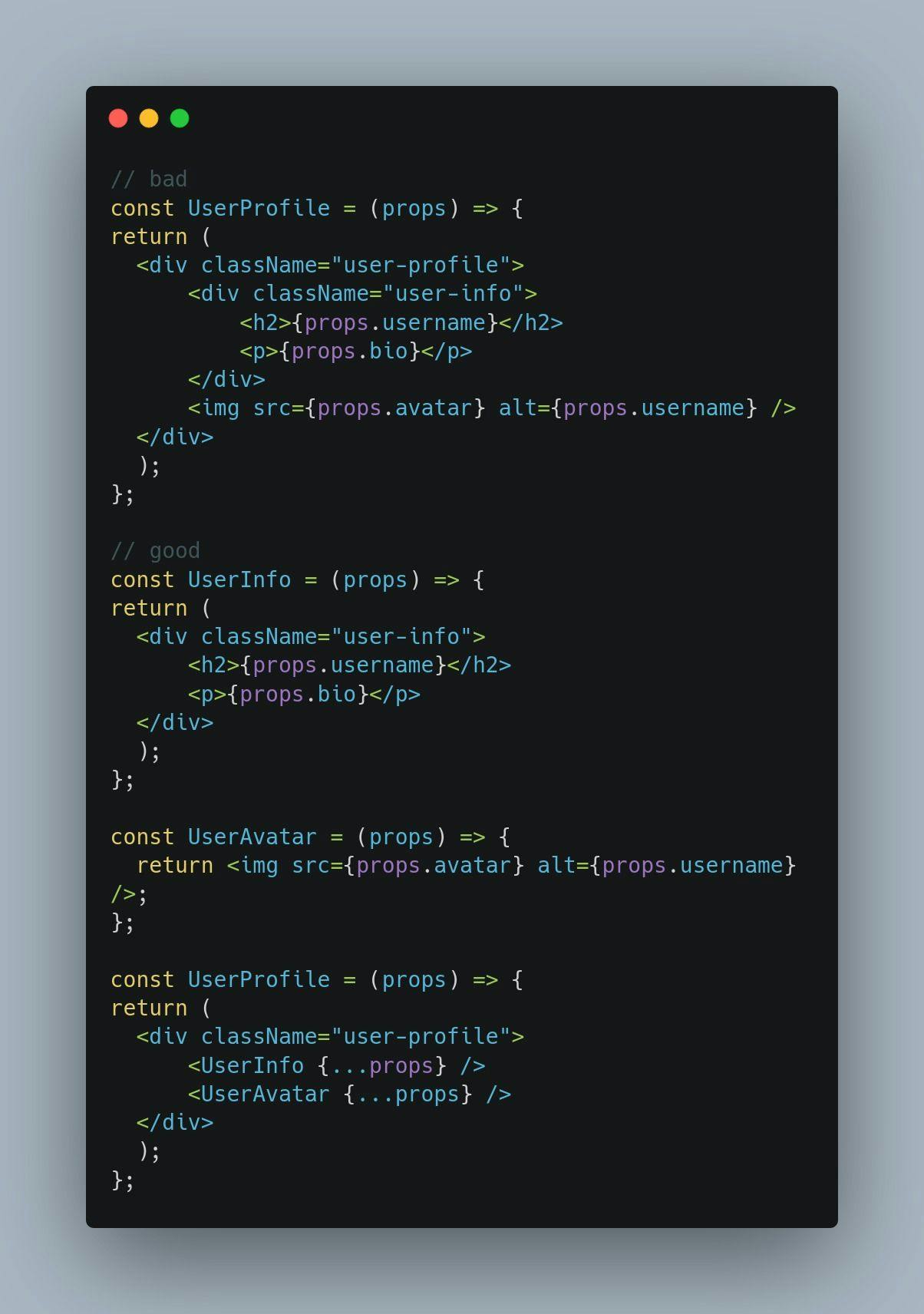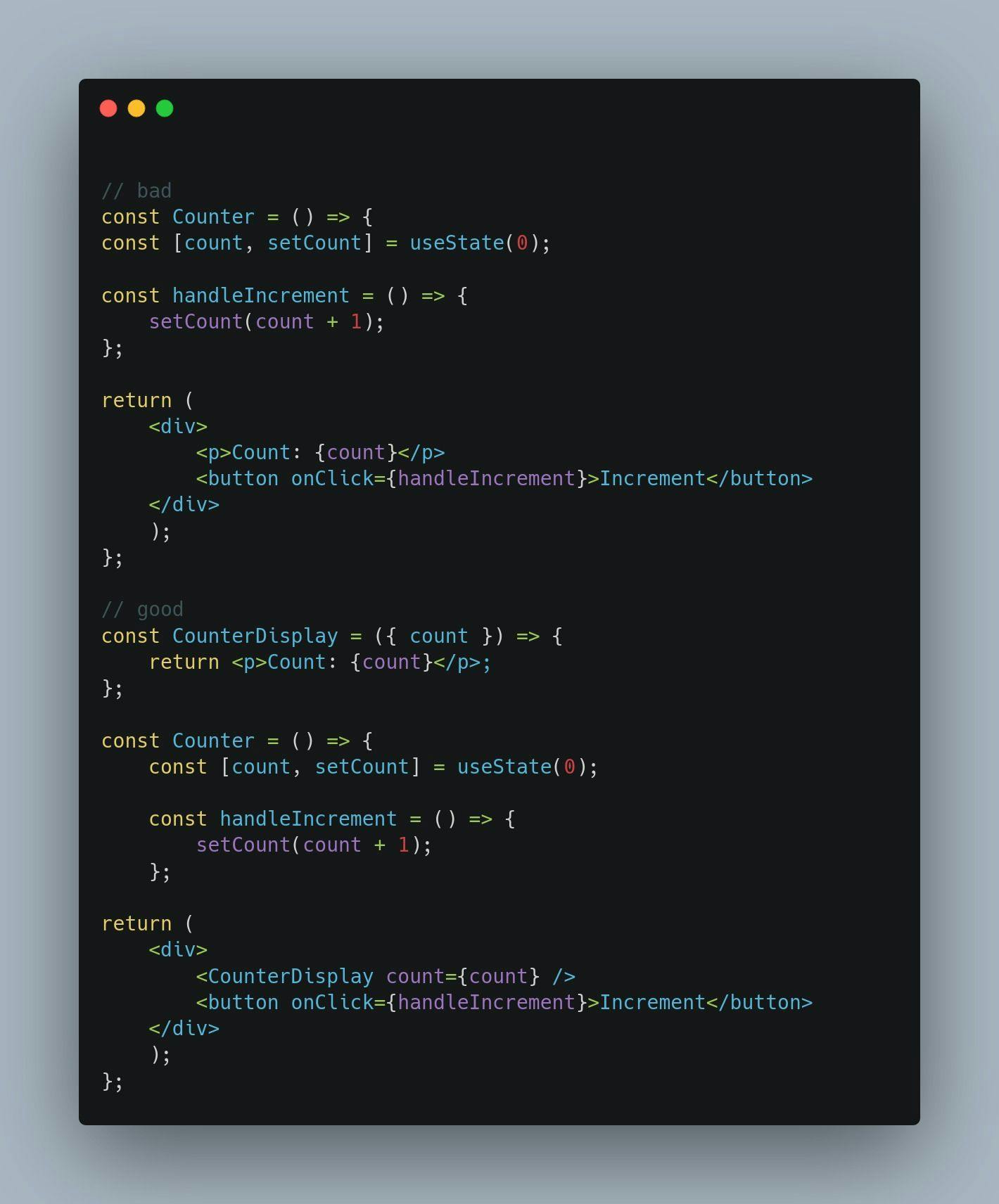10 Best Practices for Writing Clean React Code
•8 min read
- Languages, frameworks, tools, and trends

Writing clean React code is important because it reflects a careful and dedicated mindset. When we take the time to write clean, well-organized code, we are demonstrating a commitment to the craft of software development. Clean code proves that we value the quality of our work and are willing to invest the time and effort required to produce something truly exceptional.
Why is organizing and writing clean React Code important?
Clean code organization is important in React for practical reasons, as well as for its visual impact. A well-designed and well-organized codebase can be visually pleasing, making it easier to work with and understand.
When code is messy and disorganized, it can be difficult for React developers to understand how different elements come together to form the final product. This can lead to confusion for both the developer working on the code and the end users who will interact with the application.
Again, when the code is clean and well-organized, it's easier to see the relationships between different elements, understand how they fit together, and make changes as needed.
How to write clean React code?
Writing clean code is essential to make a project readable, scalable, and maintainable. Here are the ten best React tips for writing clean React code:

Use meaningful component names
Give component names that reflect their functionality. Avoid using generic names like "Box" or "DoesTheThing". Meaningful names make it easier to understand what a component does and what are its purposes in the application. Clear and concise component names reduce the cognitive load of developers, making it easier to navigate and maintain the codebase.
When working on a project with multiple developers, clear and meaningful component names help everyone to understand the code and collaborate more effectively. If a component is named according to its purpose, it will be easier to maintain, refactor, or modify in the future. Also, when you give a meaningful name to a component, it helps to locate the component in the codebase easily when debugging.

Break down components
Breaking down complex components into smaller and more manageable ones makes it easier to understand and maintain the code. Smaller components are easier to reuse across the application, making it easier to maintain and scale the codebase. Smaller components are also easier to understand, making it easier to fix bugs and add new features. Again, smaller components are easier to test, making it easier to write effective unit tests and ensure code quality. Breaking down components allows you to separate the concerns of your application and helps to manage and understand the codebase. It can help to improve the performance of your application by reducing the amount of code that needs to be rendered or processed by the browser.

Use destructuring
Destructuring props and state makes code more concise and readable. Instead of writing "props.title," you can write "const {title} = props." It allows you to extract values from objects or arrays in a more concise and readable way, reducing the amount of code you need to write. Destructuring can make your code more readable by explicitly declaring which properties or elements you are interested in.
It can also help to prevent errors while accessing properties or elements that don't exist. It becomes easier to refactor your code by analyzing which values are being used in which parts of your code and can simplify the process of passing props between components by extracting only the values that are needed.

Keep components small
Keeping components small and focused on a single responsibility makes it easier to test and debug code. Smaller components are easier to reuse across the application, making it easier to maintain and scale the codebase. They are easier to understand and maintain, making it easier to fix bugs and add new features. Smaller components are easier to test as well, making it easier to write effective unit tests and ensure code quality. Breaking down components into smaller parts allows you to separate the concerns of your application, making it easier to manage and understand the codebase. Smaller components can also help to improve the performance of your application by reducing the amount of code that needs to be rendered or processed by the browser.
In addition to these benefits, keeping components small also makes it easier to collaborate with other developers by reducing the complexity of individual components and allowing for more focused and granular discussions.

Use prop-types
Using 'prop-types' to document and validate the types of props passed to a component helps prevent errors. Prop types help to ensure that the correct data types are being passed into your components, reducing the likelihood of runtime errors. Prop types serve as documentation for your components, making it clear what types of data each component expects and what the component does with that data. They can help to identify issues with your code by providing helpful error messages when an incorrect data type is passed to a component.
Using prop types can help to facilitate collaboration between developers by making it clear what data is expected by each component and reducing confusion about how to use the component. Using prop types can improve the overall quality of your code by reducing the likelihood of runtime errors and making it more maintainable and readable.

Use functional components
Using functional components instead of class components whenever possible is wise because functional components are easier to read and write. Functional components are generally faster and more efficient than class components because they don't require a constructor or lifecycle methods.
Functional components are generally simpler and easier to read than class components because they don't have as much boilerplate code either. Functional components are typically stateless, meaning they don't maintain their own state. This makes them easier to reason about and test. They are the primary way to use React hooks, which provide a powerful way to manage state and side effects. Because functional components are typically stateless and have a clear set of inputs and outputs, they are generally easier to reason about and debug.

Avoid using inline styles
Using CSS classes instead of inline styles separates the presentation from the logic and makes it easier to maintain and update the design. Separating the styles from the component logic improves the separation of concerns, making it easier to maintain and modify the code. By keeping the styles in separate CSS files, it's easier to manage and maintain the codebase, especially when dealing with larger applications.
Using external stylesheets or CSS modules makes it even easier to reuse styles across multiple components, reducing the amount of code duplication. By separating the styles, it's easier to enable browser caching, which can help to improve the performance of the application. By having a clear separation between the styles and the component logic, it's easier to debug issues that arise with either the styles or the component logic.

Use arrow functions
Arrow functions make code more concise and easier to read. They are a better way to write functions in JavaScript, which can lead to cleaner and more readable code. Arrow functions automatically bind to the parent scope, which can be helpful in cases where you need to access the parent scope's ‘this’ keyword. Arrow functions eliminate the need to use the bind() method to bind the ‘this’ keyword to a component's method, which can simplify your code. Arrow functions can provide better performance compared to traditional functions because they don't create a new lexical scope.

Use stateless components
One should use stateless components whenever possible. Stateful components are more complex and harder to reason about. Stateless components are easier to reuse and compose since they only have to render based on the data passed to them through props. They are also easier to test since they don't have any internal state to manage. Stateless components are also generally faster and more efficient than stateful components because they don't have to manage their own state. Stateless components are also easier to scale considering their internal state management and can be easily reused across different parts of your application.

Use the spread operator
Using the spread operator (...) in your React code is important for several reasons such as it allows you to write shorter and more concise code, especially when working with arrays or objects. The spread operator allows you to create new objects or arrays without modifying the original data, which is an important principle of functional programming. It allows you to easily copy properties from one object to another, which can be useful while updating the state of a component. The spread operator allows you to merge objects, which can be useful while working with complex data structures. Or most smartly the spread operator can also be used to propagate props down to child components, reducing the amount of boilerplate code you need to write.

Conclusion
Coders have to think about ethics while writing code as the software they create can have a significant impact. For example, software used in healthcare or transportation can have life-or-death consequences, while software used in social media can influence public opinion and behavior. Therefore, coders must consider the potential consequences of their code and ensure that it is designed ethically and responsibly.
Ethical considerations play a key role in writing clean code because clean code is efficient, maintainable, ethical, and responsible. Clean code follows industry best practices and coding standards, but it also takes into account the potential impact on users. For example, clean code ensures that user data is protected, that the code is secure and free from vulnerabilities, and that the code does not contribute to further entropy than necessary. Ultimately, ethical considerations are an important aspect of writing clean code because they ensure that the code is not only effective but also ethical and responsible.

Author
Dhawal Pandya
Dhawal Pandya is a Software Developer with an optimal Venn Diagram of skills including JavaScript, ReactJS, Python, and Writing. He is always found learning new technologies and contributing to the community.